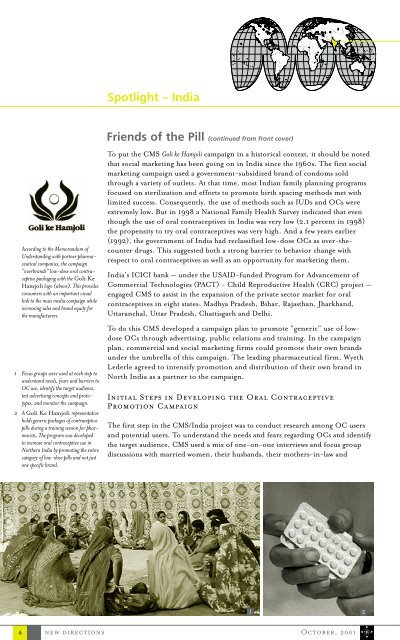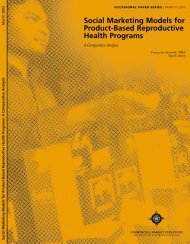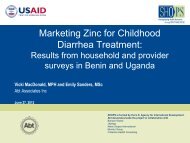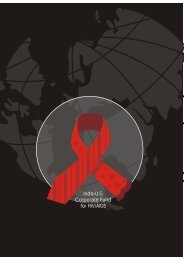new directions - (SHOPS) project
new directions - (SHOPS) project
new directions - (SHOPS) project
Create successful ePaper yourself
Turn your PDF publications into a flip-book with our unique Google optimized e-Paper software.
Spotlight – India<br />
Friends of the Pill (continued from front cover)<br />
According to the Memorandum of<br />
Understanding with partner pharmaceutical<br />
companies, the campaign<br />
“overbrands” low-dose oral contraceptive<br />
packaging with the Goli Ke<br />
Hamjoli logo (above). This provides<br />
consumers with an important visual<br />
link to the mass media campaign while<br />
increasing sales and brand equity for<br />
the manufacturers.<br />
1 Focus groups were used at each step to<br />
understand needs, fears and barriers to<br />
OC use, identify the target audience,<br />
test advertising concepts and prototypes,<br />
and monitor the campaign.<br />
2 A Goli Ke Hamjoli representative<br />
holds generic packages of contraceptive<br />
pills during a training session for pharmacists.<br />
The program was developed<br />
to increase oral contraceptive use in<br />
Northern India by promoting the entire<br />
category of low-dose pills and not just<br />
one specific brand.<br />
To put the CMS Goli ke Hamjoli campaign in a historical context, it should be noted<br />
that social marketing has been going on in India since the 1960s. The first social<br />
marketing campaign used a government-subsidized brand of condoms sold<br />
through a variety of outlets. At that time, most Indian family planning programs<br />
focused on sterilization and efforts to promote birth spacing methods met with<br />
limited success. Consequently, the use of methods such as IUDs and OCs were<br />
extremely low. But in 1998 a National Family Health Survey indicated that even<br />
though the use of oral contraceptives in India was very low (2.1 percent in 1998)<br />
the propensity to try oral contraceptives was very high. And a few years earlier<br />
(1992), the government of India had reclassified low-dose OCs as over-thecounter<br />
drugs. This suggested both a strong barrier to behavior change with<br />
respect to oral contraceptives as well as an opportunity for marketing them.<br />
India’s ICICI bank — under the USAID-funded Program for Advancement of<br />
Commercial Technologies (PACT) - Child Reproductive Health (CRC) <strong>project</strong> —<br />
engaged CMS to assist in the expansion of the private sector market for oral<br />
contraceptives in eight states: Madhya Pradesh, Bihar, Rajasthan, Jharkhand,<br />
Uttaranchal, Uttar Pradesh, Chattisgarh and Delhi.<br />
To do this CMS developed a campaign plan to promote “generic” use of lowdose<br />
OCs through advertising, public relations and training. In the campaign<br />
plan, commercial and social marketing firms could promote their own brands<br />
under the umbrella of this campaign. The leading pharmaceutical firm, Wyeth<br />
Lederle agreed to intensify promotion and distribution of their own brand in<br />
North India as a partner to the campaign.<br />
Initial Steps in Developing the Oral Contraceptive<br />
Promotion Campaign<br />
The first step in the CMS/India <strong>project</strong> was to conduct research among OC users<br />
and potential users. To understand the needs and fears regarding OCs and identify<br />
the target audience, CMS used a mix of one-on-one interviews and focus group<br />
discussions with married women, their husbands, their mothers-in-law and<br />
1 2<br />
4<br />
<strong>new</strong> <strong>directions</strong><br />
October, 2001

















